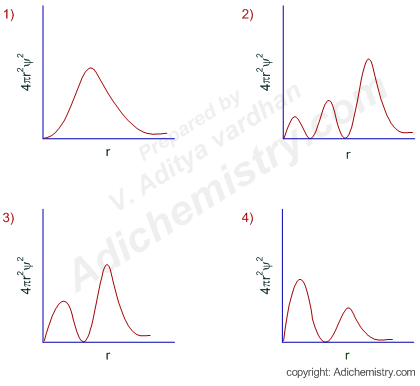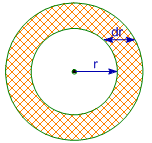draw the radial wave function for 3p and 3d orbitals
RADIAL PROBABILITY DISTRIBUTION CURVES - Atomic ORBITALS
5) The correct radial probability distribution bend for the hydrogen diminutive orbital with principal breakthrough number, n = 3 and azimuthal quantum number, l = i is: (4πr2ψ2 = radial probability density function and r = radial altitude from the nucleus)

Logic:
Radial distribution curve gives an idea well-nigh the electron density at a radial distance from the nucleus. The value of 4πriiψtwo (radial probability density part) becomes zero at a nodal point, besides known every bit a radial node.
The number of radial nodes for an orbital = n-50-1.
Where n = master quantum number and l= azimuthal breakthrough number.
Solution:
Since n = 3 and l = i for the given diminutive orbital (3p orbital), the number of radial nodes = iii-1-1 = 1.
Hence the radial probability distribution curve should contain a trough representing a radial node.
There are two graphs showing this behavior. The correct ane is option-3 since the position of principal maximum (largest peak) occurs at a greater distance. I mean the crest with greater height should be farther away from the nucleus when compared to the smaller crest.
EXTRA Information - FROM QUANTUM MECHANICS
Wavefunction, ψnlm (r,θ, Φ)
The amplitude or intensity of three-dimensional electron wave is known as Wavefunction and is represented past ψnlm (r,θ, Φ). It has both radial and angular parts.
ψnlm (r,θ, Φ) = Radial part ten Angular part = Rnl(r) ten Φlm(θ, Φ)
where,
Rnl(r) = Radial wavefunction
Φlm(θ, Φ) = Angular wavefunction
Radial probability density:
The foursquare of the radial wavefunction is known as radial probability density.
Radial probability density = Rtwo nl(r)
Radial probability:
Information technology is the probability of finding the electron within the spherical shell enclosed between a sphere of radius 'r + dr' and a sphere of radius "r' from the nucleus.

The relation between radial probability and radial probability density is given as:
Radial Probability = Radial Probability Density x Volume of spherical shell = 4πriidrR2 nl(r)
Radial probability distribution or Radial probability function:
It is also known as radial probability density function, information technology is given by 4πriiR2 nl(r). In the graphs shown in question, ψ2 is shown instead of Rtwo nl(r). Information technology gives idea about the distribution of electron density at a radial distance effectually the nucleus without because the direction or angle.
FOLLOW-UP PRACTICE QUESTIONS
RADIAL PROBABILITY DISTRIBUTION CURVES
Q-1: Which of the following statements is/are correct?
1) The radial probability distribution curves for 2s atomic orbital has one trough representing a radial node.
2) The radial probability distribution curves for 2s, 3p and 4d atomic orbitals are similar in shape (source: http://www.adichemistry.com)
3) The number of athwart nodes cannot be plant using radial distribution curves.
4) All
Answer: iv
All the statements are correct.
* The number of radial nodes for 2s orbital = north-l-i = two-0-ane = 1.
* Since 2s, 3p and 4d orbitals accept the same number of radial nodes, the radial distribution curves take similar shapes. However, the principal maxima are at unlike radial distances from the nucleus.
* Athwart nodes or nodal planes accept directional nature and hence angular part of the wavefunction should be employed to get information about them. The radial distribution curves take no inkling nigh angular nodes.
Q-ii: Which of the following atomic orbital with 1 angular node shows 3 maxima in its radial probability distribution curve?
1) 3s
2) 5d
3) 4p
4) None of the above
Reply: three
Since there are 3 maxima, the number of radial nodes must be 2. The 3s, 5d and 4p orbitals accept two radial nodes. Even so, but the p orbitals have one athwart node.
Q-3: The radial probability distribution curve obtained for an orbital wavefunction of valence electron of an alkaline earth metal atom has 4 peaks. The metallic is:
1) Potassium
ii) Calcium
three) Barium
four) Magnesium
Reply: 2
Since there are 3 peaks, the number of radial nodes is 3. Hence the valence electron of element of group ii atom resides in 4s orbital. Therefore the metal is Calcium.
Q-4: The number of peaks observed in the radial distribution curve for 4p atomic orbital is:
A) 1
B) 2
C) 3
D) 0
Reply: C
The number of radial nodes in 4p orbital = n-l-1 = 4-1-1 = 2
Therefore, the number of peaks = 3.
Abode Piece of work QUESTIONS - RADIAL PROBABILITY DISTRIBUTION CURVES
1) Is information technology possible to go the shapes of orbitals with the assistance of radial probability distribution curves?
Reply: No. Since radial probability distribution curves are plotted for electron density at radial altitude for a spherical beat, there is no direction or bending is mentioned. Hence it is not possible to become the exact shape of atomic orbitals from radial distribution curves. We have to have the support of angular distribution curves.
ii) What is exactly a radial node? (copied from adichemistry.com). What is the deviation betwixt an angular node and a radial node?
Respond: Radial nodes are regions around the nucleus where the probability of finding electron is cipher. They do not pass through the nucleus. The angular nodes are the planes where the probability of finding electron is zero and they laissez passer through the nucleus.
3) Summate the number of radial nodes for 1s, 2s, 3s, 2p, 3p, 4p, 3d, 4d & 5d orbitals.
Hint: Use the equation n-fifty-ane.
4) How many radial nodes are there in 4f orbital?
Reply: number of radial nodes = n-l-1 = 4 - 3 - one = 0 radial nodes for 4f orbital.
5) At what distance is the radial probability maximum for 1s orbital?
Answer: 0.053 nm. It is equal to the Bohr's radius of 1st orbit in hydrogen atom.
6) Radial probability distribution curves are the plots of 4πrtwoψtwo vs distance from the nucleus. The bend has number of maxima which is different for different orbitals. The number of spherical nodes present in 4p orbital and 5d orbital respectively are,................. (Answer: two & 2)
7) The variation of radial probability density Rii (r) as a office of distance r of the electron from the nucleus for 3p orbital, when shown graphically, the graph shows .......... peaks with the smallest ane ......... to the nucleus. (Reply: 2, closer)
8) The radial probability distribution function for a hydrogen atom state has one elevation, at r = 0.476 nm. The nl spectroscopic notation of this land is......? (solved - free)
A) 3p
B) 3d
C) 4f
D) 2p
Answer: radius of nth orbit (r) = 0.053 x n2 nm
Plugin the values now, 0.476 = 0.053 x north2 nm
or north = 3
Since the graph has only one peak, there is no nodal region. This is possible for 3d orbital.
9) The probability distribution curve for 2s electron appears like that of:
1) 1s orbital
2) 2p orbital
iii) 3p orbital
4) 3d orbital
Answer: three
10) Draw the graph of radius of orbit in hydrogen atom every bit a function of orbit number.
eleven) What is the value of (north + l + r) in a given moving ridge function, where due north = principle quantum number and l = azimuthal quantum number and r = total number of node nowadays in given moving ridge part =181(6π)1/2(Za)7/2r2e−Zt/3a(3cos2θ−one)
12) The radial probability curve obtained for an orbital wave function has 3 peaks and 2 radial nodes. The valence electron of which one of the post-obit metals does this wave office correspond to:
A) Ca
B) Mg
C) Li
D) Cs
Answer: B
Source: https://www.adichemistry.com/jee/main/1/a5.html
0 Response to "draw the radial wave function for 3p and 3d orbitals"
Post a Comment